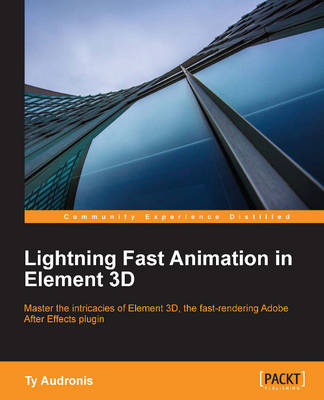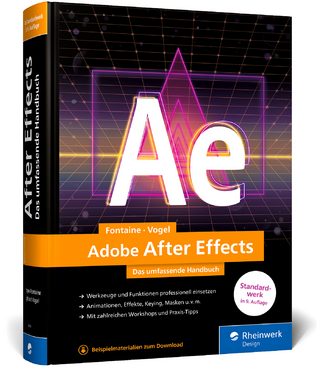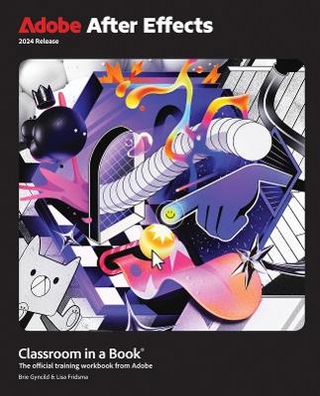
Lightning Fast Animation in Element 3D
Packt Publishing Limited (Verlag)
978-1-78355-938-1 (ISBN)
- Titel ist leider vergriffen;
keine Neuauflage - Artikel merken
Ty Audronis has a rather unique background in the media world. He's often asked how he got into the field. Well, it's a bit of a story, but he'll be as brief as possible narrating it in his own words. I had the great benefit of having a father in the semiconductor industry and an overachieving (to say the least) family. So, my family was the first of all my friends to have a computer in 1980 (well, maybe 1981, I'm not sure). When other kids were fooling around, I was out hooking up neighbors' computers and showing them how to use them. I was only seven (or eight). In the mid 80s, my father hired me to do some quality assurance (QA), and illustrations for his software. This was my first paid graphics gig (laughable by today's standards). I used 'Dr. Halo' on a monochrome computer, but still, that was a huge advantage over other kids. At the same time, I was learning music and programming, and doing anything where I could mix art and technology. Remember that Star Trek: The Next Generation episode where that kid got hold of a cool laser thing that meant he could sculpt anything he liked? That was me, tech and art all the way. After some difficulties in the music world after high school, I joined the Navy. I forgot all about art for the time but stayed with technology. I was stationed in Japan and served aboard the USS Independence (CV62) from 19921994 in a helicopter squadron. No, I wasn't a pilot or anything glamorous (just a lowly E3). I got hurt in a typhoon off the coast of Guam and was retired. The Navy began to pay for my college fees, and I decided to be a lawyer. I won many debates, and got a national bronze medal for informative speaking. However, my mentor for the debates told me not to be a lawyer. She said that I debate effectively but I couldn't stand people lying. She said I'd have a heart attack before 35, so I went into marketing. Why is all of this relevant? Because inadvertently, I found art again. I figured, 'I may as well learn about animation and production, because I'll need to tell them what I want in their language.' So, I took a computer animation class. This is really where my career took shape. The class was taught by a man that was to become my mentor, Rick Vertolli. He and his assistant (Randy Wall) shaped my animation skills, and resparked my desire to create. After that class in Wavefront (yes, way back then, our workstations were Silicon Graphics 'Indy' machines), I found myself interning for Rick over the summer and rewriting the text book to be used in Lightwave and later, Maya. This was the first taste I had of writing howtos. Over the years, I became Rick's assistant, lectured several times, and was the fulltime lab assistant. I changed my major to a special major in Computer Generated Special Effects. I also won my first award in animation during this time (a 'Rosebud'). After working with Rick, Randy, and Chris Ficken as an intern and lab assistant for four years, I was recruited by frog Design as a design technologist. My knowledge of programming and graphics was unique and was in high demand during the .coms. Those were the days. We had our desks in a circle with a model train and slot car track with every video game system on the market, coffee time at 4 PM, soccer in South Park (in San Francisco) at 5 PM, and unreal tournaments across the intranet (against other frog offices worldwide) at 5:30 PM nearly every day. Yes, we worked hard but we played hard too. Sorry, I digress. At frog, I got to work with some of the world's best companies, had access to design, animation, web development, and just about every toy a geek artist could desire. But then, .com turned into .bomb and layoffs came. I still remember lunches on Bryant St. in San Francisco and going up and down the street to auctions in Web MD and Pets.com (to name a few). Cars were clogging San Jose International airport (techs on H1 visas just abandoning their Mercedes and BMWs and flying back home to England, France, India, and so on). An auction car would be a steal back then; times were scary. My first child was born; I was terrified. So, I returned to entertainment. I went to a local TV station in Chico, CA and worked on producing ads for a few months. I moved on to an ad agency for a few years (worst job ever). Then, I met up with another mentor of mine, Robert (Bob) Condos. Bob gave me my first real production gig. I came on a show called 'So, You Want to Be a Star' as the producer, with Bob as the EP. Everything up to this point in my career was a concept. I used every bit of my art, tech, and personal knowledge, and we pulled off the impossible. It was a 14week show on a shoestring budget. In the end, I was the producer, director, and editor. We had a lot of help from some great people but I learned a lot during that show. It's still my favorite experience in entertainment; not the most prestigious, not the most recognizable, but the best. This is when my second child was born. At the same time, I was in a partnership that started an Internet radio station that catered to MMO gamers in Matrix Online. Machine radio was fun, amazing, and a great experience. I learned a lot about online community building, appealing to markets, and what appeals to people in general. I couldn't devote enough time to machine radio (due to the TV show I was producing), so I let one of the partners take over—a decision I'll regret until the day I depart this sweet earth. The station then died. After a few nondescript tech jobs, I was recruited to California Academy of Sciences in San Francisco to help with the web redesign during their rebuild in 2007. Near the end of the web relaunch, the Planetarium Director heard that I had some TV experience. So, I had lunch with him and gave him a few nuggets of advice on setting up the Science Visualization studio (basically, a full production and effects department for the purpose of making visual representations of scientific principles, among which are planetarium shows). We built the (at that time) world's largest alldigital dome, a 3D theater, and a full animation and editing department. It was amazing. We won many international awards and played with some of the entertainment industry's hottest technology. The next four years were spent as the senior/supervising editor of Science Visualization there. It depends on who you ask and what year it was as to whether I was senior or supervising. It was the same job and I'm not too hung up on titles so... meh. I got to work with some great people, make some good friends, and work on some mindblowing projects (from going to NASA rocket launches to talks with Neil Tyson to programming interactive exhibits to making friends with Pierre the Penguin). This was truly a great time in my career. However, nothing lasts forever and eventually, my position was removed from the department and I was laid off. I spent some time teaching, spent some time contracting (again, with frog, some movies, and so on), and eventually landed at a TV production company. A year of 'murderporn' (as South Park calls shows like I [Almost] Got Away With It) for Investigation Discovery, some travel channel, and History shows. I hate what cable television has become, but it's a living and it pays fairly well. Now, I've moved away from civilization, and my wife and I live in a small town off Interstate5 in Northern California. It's private, quiet, and I still get to have my fun. Currently, I am strictly a contractor. I work on anything from court cases (graphic simulations, recreations, audio/video cleanup, and so on) to feature movies. I also write for Videomaker magazine occasionally. Yes, I still do a lot of graphics. However, what I'm enjoying the most right now is shooting with drones. It's a mix of my media and Navy careers, and it's truly fun. So, that's my career. Well, at least the brief summary of it. How did I get into this business? Luck. A series of coincidences and opportunities (that turned out just right) have led to my success. Don't get me wrong; I've worked very hard. However, I've truly been blessed. Not just with opportunity, but with the people who have given me these opportunities. I'd like to thank all of the people mentioned above (Rick Vertolli, Randy Wall, Chris Ficken, Bob Condos, the entire staff at 'So, You Want to Be a Star', and the amazing folks I've worked with over the years).
| Erscheint lt. Verlag | 26.3.2014 |
|---|---|
| Verlagsort | Birmingham |
| Sprache | englisch |
| Maße | 191 x 235 mm |
| Themenwelt | Kunst / Musik / Theater ► Fotokunst |
| Informatik ► Grafik / Design ► Film- / Video-Bearbeitung | |
| ISBN-10 | 1-78355-938-1 / 1783559381 |
| ISBN-13 | 978-1-78355-938-1 / 9781783559381 |
| Zustand | Neuware |
| Informationen gemäß Produktsicherheitsverordnung (GPSR) | |
| Haben Sie eine Frage zum Produkt? |
aus dem Bereich


